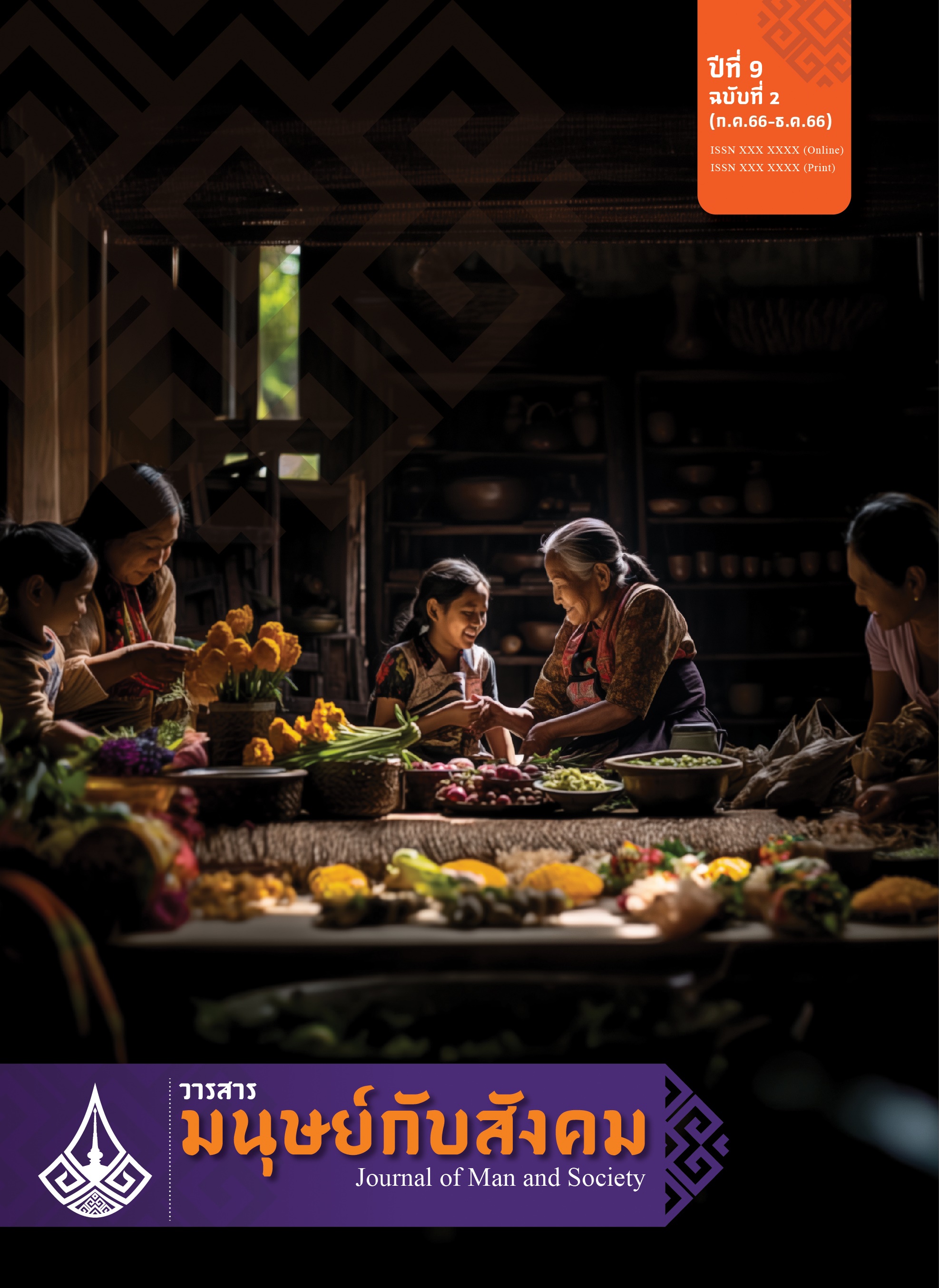Pattern and Issue of Mahasarakham University’s Social Responsibility Communication
Main Article Content
Abstract
This research investigated the predictive factors for social responsibility communication at Mahasarakham University in the future. This is the quantitative research via survey from the sample group exposed to news about Mahasarakham University’s social responsibility. The data set used was comprised of questionnaires completed by 603 participants. Percentage, mean, and standard deviation were the statistics employed in data analysis. Multiple regression analysis using the enter method was utilized to predict the social responsibility communication of Mahasarakham University in the future.
The results indicated the variables of communication components of Mahasarakham University’s Social Responsibility in four aspects: sender, message, channel and receiver. These helped predict the desired future social responsibility communication pattern of Mahasarakham University by 36 percent (R2 = 0.36) with a statistical significance of 0.05. Meanwhile, the variables of Mahasarakham University’s mission content were five aspects: teaching, research, academic service, the development of students and the development of environmentalism. These help predict the desired future social responsibility communication issue of Mahasarakham University by 43 percent (R2 = 0.43) with a statistical significance of 0.05.
Article Details

This work is licensed under a Creative Commons Attribution-NonCommercial-NoDerivatives 4.0 International License.
เนื้อหาและข้อมูลที่ตีพิมพ์ลงในวารสารมนุษย์กับสังคม ถือเป็นข้อคิดเห็นและความรับผิดชอบโดยตรงของผู้เขียนซึ่งกองบรรณาธิการวารสารไม่จำเป็นต้องเห็นด้วยหรือร่วมรับผิดชอบใดๆ
บทความ ข้อมูล เนื้อหา รูปภาพ ฯลฯ ที่ได้รับการตีพิมพ์ในวารสารมนุษย์กับสังคม ถือเป็นลิขสิทธิ์ของวารสาร หากบุคคลหรือหน่วยงานใดต้องการนำทั้งหมดหรือส่วนหนึ่งส่วนใดไปเผยแพร่ต่อต้องอ้างอิงวาสาร
References
กิติยา ปรัตถจริยา และ ปาริชาต สถาปิตานนท์. (2552). การสื่อสารความรับผิดชอบต่อสังคมของผู้ประกอบการธุรกิจบุหรี่. [วิทยานิพนธ์นิเทศศาสตรมหาบัณฑิต, จุฬาลงกรณ์มหาวิทยาลัย]. Chulalongkorn University Intellectual Repository (CUIR). http://cuir.car.chula.ac.th/handle/123456789/18716
จิดาภา ล้อมพิทักษ์ และ ปาริชาต สถาปิตานนท์. (2564). การสื่อสารความรับผิดชอบต่อสังคมของกลุ่มผู้ประกอบการโทรทัศน์ไทย. [วิทยานิพนธ์นิเทศศาสตรมหาบัณฑิต, จุฬาลงกรณ์มหาวิทยาลัย]. Chulalongkorn University Intellectual Repository (CUIR). http://cuir.car.chula.ac.th/handle/123456789/80972
ชิรวัฒน์ นิจเนตร. (2561). การเรียนรู้ด้วยการบริการสังคม: ทางเลือกหนึ่งในการรับใช้สังคมของมหาวิทยาลัย. วารสารราชภัฎสุราษฎร์ธานี, 5(1), 1-32.
ดรุณศักดิ์ ตนิยะลาภะ. (2560). อุดมศึกษาสาขาวิชาที่ถูกลืม: มหาวิทยาลัยไทยบนเส้นทางแห่งการปรับตัวและการแปลงเปลี่ยนสู่ยุค “หลังโลกาภิวัตน์” กับการเป็นมหาวิทยาลัยที่มีคุณค่า. มหาวิทยาลัยธุรกิจบัณฑิตย์.
พิชญ์ณัฐ เนื่องจำนงค์ และ ปาริชาต สถาปิตานนท์. (2560). การสื่อสารความรับผิดชอบต่อสังคมขององค์กรเพื่อการสร้างความผูกพันของพนักงาน. [วิทยานิพนธ์นิเทศศาสตรดุษฎีบัณฑิต, จุฬาลงกรณ์มหาวิทยาลัย]. Chulalongkorn University Intellectual Repository (CUIR). http://cuir.car.chula.ac.th/handle/123456789/60038
พรธิดา วิเศษศิลปานนท์. (2562). การขับเคลื่อนความรับผิดชอบต่อสังคมของมหาวิทยาลัยที่มีผลต่อนักศึกษา. Veridian E-Journal, Silpakorn University, 12(3). 572-590.
ธานินทร์ ศิลป์จารุ. (2563). การวิจัยและวิเคราะห์ข้อมูลทางสถิติด้วย SPSS และ AMOS (พิมพ์ครั้งที่ 18). ห้างหุ้นส่วนสามัญบิสซิเนสอาร์แอนด์ดี.
ธิติพัทธ์ ลิ้มสัมฤทธิ์นิภา และจันทิมา เขียวแก้ว. (2562). การพัฒนารูปแบบการสื่อสารเพื่อสร้างคุณค่าตราองค์กรของสถาบันอุดมศึกษาตามแนวคิดพันธกิจสัมพันธ์วิทยานิพนธ์. [วิทยานิพนธ์นิเทศศาสตรดุษฎีบัณฑิต ไม่ได้ตีพิมพ์]. มหาวิทยาลัยหอการค้าไทย.
วศินี นพคุณ และ พัชนี เชยจรรยา. (2551). กลยุทธ์การสื่อสารเรื่องความรับผิดชอบต่อสังคม และการมีส่วนร่วมของชุมชนด้านสิ่งแวดล้อมของกลุ่มอุตสาหกรรมพลังงาน. [วิทยานิพนธ์นิเทศศาสตรมหาบัณฑิต, จุฬาลงกรณ์มหาวิทยาลัย]. Chulalongkorn University Intellectual Repository (CUIR). http://cuir.car.chula.ac.th/handle/123456789/31820
วิจิตร ศรีสอ้าน. (2562). “พันธกิจสัมพันธ์ตามศาสตร์พระราชา เพื่อสร้างคุณค่าและพัฒนาชุมชนท้องถิ่นอย่างยั่งยืน” เอกสารประกอบการประชุมวิชาการ The 6th Engagement Thailand Annual Conference 2019. มหาวิทยาลัยราชภัฏอุตรดิตถ์. อุตรดิตถ์. ประเทศไทย
Ali, M., Mustapha, I., Osman, S., & Hassan, U. (2021). University social responsibility: A review of conceptual evolution and its thematic analysis. Journal of Cleaner Production, 286, 124931. https://doi.org/10.1016/j.jclepro.2020.124931
Asemah, E., Okpanachi, R., & Olumuji, E. (2013). Universities and Corporate Social Responsibility Performance: An Implosion of the Reality. African Research Review, 7(4), 195-224. https://doi.org/10.4314/afrrev.v7i4.12
Bernardo, M. A. C., Butcher, J., & Howard, P. (2012). An international comparison of community engagement in higher education. International Journal of Educational Development, 32(1), 187–192. https://doi.org/10.1016/j.ijedudev.2011.04.008
Benitez, J., Ruiz, L., Castillo, A., & Llorens, J. (2020). How corporate social responsibility activities influence employer reputation: The role of social media capability. Decision Support Systems, 129, 113223. https://doi.org/10.1016/j.dss.2019.113223
Carroll, A. B. (2016). Carroll’s pyramid of CSR: taking another look. International Journal of Corporate Social Responsibility, 1(1). https://doi.org/10.1186/s40991-016-0004-6
Christine I. C. (2011). The effect of participation in experiential learning programs on personal and civic attitudes. Doctor of Philosophy: Program in Clinical Psychology.
Cochran, W.G. (1953). Sampling Techniques. John Wiley & Sons. Inc.
Grover, P., Kar, A. K., & Ilavarasan, P. V. (2019). Impact of corporate social responsibility on reputation—Insights from tweets on sustainable development goals by CEOs. International Journal of Information Management, 48, 39–52. https://doi.org/10.1016/j.ijinfomgt.2019.01.009
Khamis, N. I., & Wan Ismail, W. K. (2022). The impact of corporate social responsibility on corporate image in the construction industry: a case of SMEs in Egypt. Journal of Sustainable Finance & Investment, 12(1), 128-146. https://doi.org/10.1080/20430795.2021.1930992
Kouatli, I. (2019). The contemporary definition of university social responsibility with quantifiable sustainability. Social Responsibility Journal, 15(7), 888–909. https://doi.org/10.1108/srj-10-2017-0210
Leko Šimić, M., Sharma, E., & Kadlec, E. (2022). Students’ Perceptions and Attitudes toward University Social Responsibility: Comparison between India and Croatia. Sustainability, 14(21), 13763. https://doi.org/10.3390/su142113763
Meseguer-Sánchez, V., Abad-Segura, E., Belmonte-Ureña, L. J., & Molina-Moreno, V. (2020). Examining the Research Evolution on the Socio-Economic and Environmental Dimensions on University Social Responsibility. International Journal of Environmental Research and Public Health, 17(13), 4729. https://doi.org/10.3390/ijerph17134729
Santos-Jaén, J. M., Madrid-Guijarro, A., & García-Pérez-de-Lema, D. (2021). The impact of corporate social responsibility on innovation in small and medium-sized enterprise: The mediating role of debt terms and human capital. Corporate Social Responsibility and Environmental Management, 28(4), 1200–1215. https://doi.org/10.1002/csr.2125
Sousa, J. C. R. D., Siqueira, E. S., Binotto, E., & Nobre, L. H. N. (2020). University social responsibility: perceptions and advances. Social Responsibility Journal, 17(2), 263–281. https://doi.org/10.1108/srj-10-2017-0199
Wang, R., & Chan-Olmsted, S. (2020). Content marketing strategy of branded YouTube channels. Journal of Media Business Studies, 17(3–4), 294–316. https://doi.org/10.1080/16522354.2020.1783130
Ward, H., Wilson, E., & Zarsky, L. (2007). CSR and developing countries. Sustainable Development Innovation Briefs, 1, 1-8.


